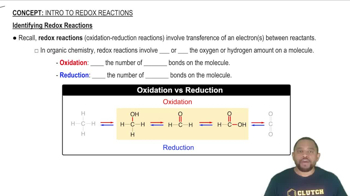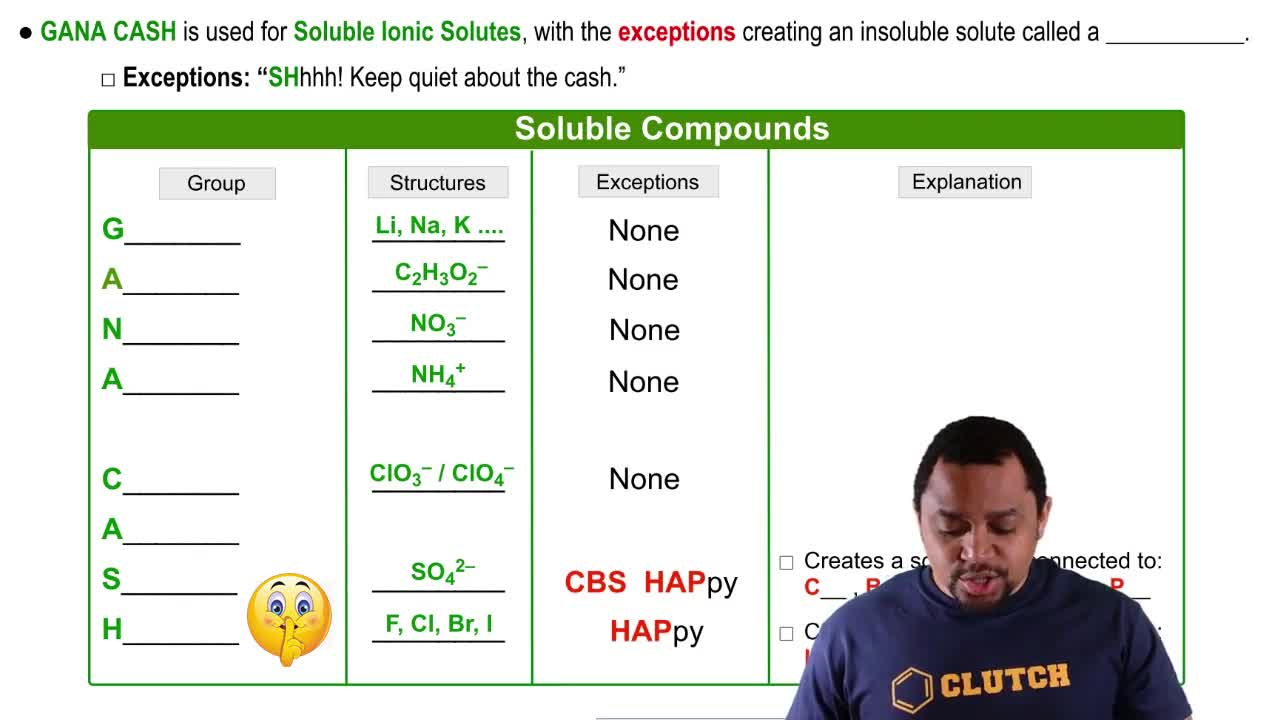A 1.248-g sample of limestone rock is pulverized and then treated with 30.00 mL of 1.035 M HCl solution. The excess acid then requires 11.56 mL of 1.010 M NaOH for neutralization. Calculate the percentage by mass of calcium carbonate in the rock, assuming that it is the only substance reacting with the HCl solution.
Ch.4 - Reactions in Aqueous Solution
Chapter 4, Problem 92d
The accompanying photo shows the reaction between a solution of Cd(NO3)2 and one of Na2S. (d) Is this a redox reaction?
 Verified step by step guidance
Verified step by step guidance1
Identify the reactants and products in the reaction: Cd(NO_3)_2 and Na_2S react to form CdS and NaNO_3.
Determine the oxidation states of each element in the reactants and products. For example, in Cd(NO_3)_2, Cd is +2 and in Na_2S, S is -2.
Check if there is a change in oxidation states for any of the elements from reactants to products. In CdS, Cd is still +2 and S is still -2, indicating no change.
Since there is no change in oxidation states, this indicates that no electrons are transferred between the elements.
Conclude that the reaction is not a redox reaction, as there is no change in oxidation states of the elements involved.

Verified video answer for a similar problem:
This video solution was recommended by our tutors as helpful for the problem above.
Video duration:
2mWas this helpful?
Key Concepts
Here are the essential concepts you must grasp in order to answer the question correctly.
Redox Reactions
Redox reactions, or reduction-oxidation reactions, involve the transfer of electrons between two species. In these reactions, one substance is oxidized (loses electrons) while another is reduced (gains electrons). Identifying whether a reaction is a redox process requires analyzing the oxidation states of the elements involved before and after the reaction.
Recommended video:
Guided course

Identifying Redox Reactions
Oxidation States
Oxidation states (or oxidation numbers) are a way to keep track of electrons in chemical reactions. They indicate the degree of oxidation of an atom in a compound, helping to determine whether an atom has gained or lost electrons. In the context of the given reaction, calculating the oxidation states of cadmium (Cd) and sulfur (S) will clarify if any changes occur, indicating a redox reaction.
Recommended video:
Guided course

Oxidation Numbers
Ionic Compounds and Solubility
Ionic compounds, such as Cd(NO3)2 and Na2S, dissociate into their constituent ions when dissolved in water. Understanding the solubility of these compounds is crucial, as it affects the reaction dynamics. The formation of precipitates or soluble ions can influence whether a redox reaction occurs, as the physical state of the reactants can determine the pathway of the reaction.
Recommended video:
Guided course

Soluble Ionic Solutes
Related Practice
Textbook Question
Textbook Question
Uranium hexafluoride, UF6, is processed to produce fuel for nuclear reactors and nuclear weapons. UF6 is made from the reaction of elemental uranium with ClF3, which also produces Cl2 as a by-product. b. Is this a metathesis reaction?
Textbook Question
The accompanying photo shows the reaction between a solution of Cd(NO3)2 and one of Na2S. (b) What ions remain in solution?
Textbook Question
Antacids are often used to relieve pain and promote healing in the treatment of mild ulcers. Write balanced net ionic equations for the reactions between the aqueous HCl in the stomach and each of the following substances used in various antacids: (a) Al(OH)3(s) (b) Mg(OH)2(s) (c) MgCO3(s) (d) NaAl(CO3)(OH)2(s) (e) CaCO3(s).
